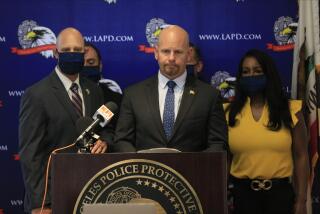Gates Defends SIS Unit in McDonald’s Holdup : Courts: Testifying in $1-million lawsuit, former police chief says intervention might have put the restaurant manager’s life in danger.
Former Los Angeles Police Chief Daryl F. Gates on Tuesday resolutely defended a special police surveillance unit for waiting outside a McDonald’s for more than 30 minutes while its manager was held inside at gunpoint during a 1990 robbery--saying that citizens are misled by the ease with which police defeat criminals on TV.
Any other action could have increased the danger to the manager, Gates testified in a Glendale Superior Court trial in which the manager is suing the city, alleging that the officers failed in their responsibility to protect her.
Gates said he felt great sympathy for the manager, Robbin L. Cox, but suggested that her lawsuit was applying a television standard of what police are capable of doing.
“People watch television too much and don’t know how difficult this is,” Gates said, referring to the work of the Special Investigations Section, which follows suspected dangerous felons in hopes of catching them committing a crime.
Gates said surveillance is an extremely complicated and iffy business and that for the officers to burst into the restaurant after the four men broke in could have precipitated a shootout in which Cox would have been killed or injured.
Cox’s attorney, Christopher Hiddleson, has said his client will ask for $1 million in damages from the city and the Police Department for failing to try to rescue Cox, whom the robbers had blindfolded and threatened to kill if she did not open the restaurant safe.
The unit moved in when the robbers left the restaurant on Foothill Boulevard in Sunland. Authorities say a gunfight broke out and three of the four robbers were killed. The fourth man, who was wounded, is serving a 17-year prison sentence.
Hiddleson called Gates to testify on police procedure and about Gates’ actions in reviewing the official investigation of the incident.
Hiddleson asked Gates to read two policies from the LAPD Manual. One defined “reverence for human life” as the primary consideration in tactics, and the other declared the arrest of the perpetrator of a crime “subordinate to the protection of life.”
However, Gates insisted that consideration for Cox’s safety guided the unit leader, Detective Brian Davis, in his decision to hold the SIS team outside the restaurant, and to order that uniformed officers responding to Cox’s call to 911 for help be ordered away from the scene.
Members of the undercover surveillance team dress in scruffy civilian clothes and could “look like the suspects” to a uniformed officer, possibly leading to an unpredictable confrontation between the two police groups, he said.
Hiddleson asked whether surveillance officers were not supposed to keep the suspects in sight at all times.
“It’s not that simple,” Gates said. “It’s not as you see in TV where they follow people closely. It’s very complex. Your cover can be blown very easily. You often have to stay in a place where you can’t see everything that is going on.
“You do your best without trying to totally blow the operation. Once you blow the operation, the suspects are gone. You can’t arrest them. Your opportunity to take them off the street has been lost.”
The SIS has already lost one suit in the widely publicized McDonald’s case. A federal court jury found that the officers acted without cause when they fired on the robbers, awarding $44,000 in damages to the families of the dead men and the survivor. Almost half of that award was levied against Gates personally, who the jury said condoned the use of excessive force in the department.
Later in the day, a retired FBI agent called as Hiddleson’s final witness contradicted Gates. James P. Graham, who said he has preformed surveillance many times in his 22 years with the agency, testified that the police should have telephoned Cox inside to warn her, and later should have declared a hostage situation to bring in the full force of the department.
Graham also said the surveillance leader could easily have posted an officer behind a wall on the west side of the restaurant where the robbers entered.
They could have broken off a tree branch to hide behind while they looked over the wall, Graham said.
Attorneys said they expect the trial to go to the jury today.
More to Read
Sign up for Essential California
The most important California stories and recommendations in your inbox every morning.
You may occasionally receive promotional content from the Los Angeles Times.










